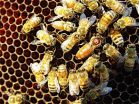(Press-News.org) A new long-term study of honey bee health has found that a little-understood disease study authors are calling "idiopathic brood disease syndrome" (IBDS), which kills off bee larvae, is the largest risk factor for predicting the death of a bee colony.
"Historically, we've seen symptoms similar to IBDS associated with viruses spread by large-scale infestations of parasitic mites," says Dr. David Tarpy, an associate professor of entomology at North Carolina State University and co-author of a paper describing the study. "But now we're seeing these symptoms – a high percentage of larvae deaths – in colonies that have relatively few of these mites. That suggests that IBDS is present even in colonies with low mite loads, which is not what we expected." The study was conducted by researchers from NC State, the University of Maryland, Pennsylvania State University and the U.S. Department of Agriculture (USDA).
The study evaluated the health of 80 commercial colonies of honey bees (Apis mellifera) in the eastern United States on an almost monthly basis over the course of 10 months – which is a full working "season" for commercial bee colonies. The goal of the study was to track changes in bee colony health and, for those colonies that died off, to determine what factors earlier in the year may have contributed to colony death. Fifty-six percent of the colonies died during the study.
"We found that colonies affected by IBDS had a risk factor of 3.2," says Dr. Dennis vanEnglesdorp of the University of Maryland, who was lead author on the paper. That means that colonies with IBDS were 3.2 times more likely to die than the other colonies over the course of the study.
While the study found that IBDS was the greatest risk factor, a close runner-up was the occurrence of a so-called "queen event."
Honey bee colonies have only one queen. When a colony perceives something wrong with its queen, the workers eliminate that queen and try to replace her. This process is not always smooth or successful. The occurrence of a queen event had a risk factor of 3.1.
"This is the first time anyone has done an epidemiological study to repeatedly evaluate the health of the same commercial honey bee colonies over the course of a season," Tarpy says. "It shows that IBDS is a significant problem that we don't understand very well. It also highlights that we need to learn more about what causes colonies to reject their queens. These are areas we are actively researching. Hopefully, this will give us insights into other health problems, including colony collapse disorder."
INFORMATION:
The paper, "Idiopathic brood disease syndrome and queen events as precursors of colony mortality in migratory beekeeping operations in the eastern United States," is published in the February issue of Preventive Veterinary Medicine. Co-authors of the study include Dr. Eugene Lengerich of Penn State and Dr. Jeffery Pettis of USDA. The work was supported by USDA and the National Honey Board.
Researchers id queens, mysterious disease syndrome as key factors in bee colony deaths
2013-03-04
ELSE PRESS RELEASES FROM THIS DATE:
Daily HIV prevention approaches didn't work for African women in the VOICE study
2013-03-04
ATLANTA, March 4, 2013 – Results of a major HIV prevention trial suggest that daily use of a product – whether a vaginal gel or an oral tablet – does not appear to be the right approach for preventing HIV in young, unmarried African women.
Of the three products tested in the VOICE Study – tenofovir gel, oral tenofovir and oral Truvada® – none proved to be effective among the 5,029 women enrolled in the trial; most participants did not use them daily as recommended. Drug was detected in less than a third of blood samples from women who were assigned to use either Truvada ...
Grandmother's cigarette habit could be the cause of grandchild's asthma
2013-03-04
LOS ANGELES – (March. 4, 2013) – Grandmother's cigarette smoking could be responsible for her grandchild's asthma, and the recent discovery of this multi-generational transmission of disease suggests the environmental factors experienced today could determine the health of family members for generations to come, two Los Angeles Biomedical Research Institute (LA BioMed) lead researchers write in the March edition of Review of Obstetrics & Gynecology.
The researchers, John S. Torday, PhD, and Virender K. Rehan, MD, wrote an editorial citing recent studies by Dr. Rehan that ...
Vanderbilt study finds maternal diet important predictor of severity for infant RSV
2013-03-04
An important predictor of the severity of respiratory syncytial virus (RSV) in infants may be what their mothers ate during pregnancy, according to a Vanderbilt study published in the American Journal of Respiratory and Critical Care Medicine.
RSV is the most common cause of severe lower respiratory tract disease among infants and young children worldwide. Currently there is no effective vaccine against RSV. Outbreaks occur in communities each year, usually lasting 4-5 months during the fall, winter and/or spring months.
Lead author Fernando Polack, M.D., Cesar Milstein ...
Recon 2 modeling may help tailor treatments for patients with metabolic diseases, cancer
2013-03-04
An international team of researchers, including an investigator with the Virginia Bioinformatics Institute at Virginia Tech, has produced what may be the most comprehensive computer model of human metabolism yet developed.
The discovery, detailed Sunday (March 3, 2013) in the journal Nature Biotechnology, advances understanding of human metabolism in health and disease. Called Recon 2, the model builds and improves upon earlier-generation metabolic reconstruction systems and may be useful for finding biomarkers of metabolic diseases, such as glycogen storage disorder, ...
New American Chemical Society video explains why cats lack a sweet tooth
2013-03-04
Do cats purrr-ferrr sardines or sweets? The American Chemical Society (ACS), the world's largest scientific society, today released a new Bytesize Science video that explains why cats, unlike humans and other mammals, are indifferent to sweet flavors. Produced by the ACS Office of Public Affairs, it is available at www.BytesizeScience.com.
The video was filmed at the Monell Chemical Senses Center, an institute dedicated to research on taste and smell. Prior to becoming Monell's Director, Gary Beauchamp, Ph.D., studied the sweet taste receptor genes of cats in the late ...
New report analyzes potential impact of sequestration on CHCs and underserved communities
2013-03-04
WASHINGTON and NEW YORK— A new report by the Geiger Gibson/RCHN Community Health Foundation Research Collaborative at the George Washington University School of Public Health and Health Services (SPHHS) examines the potential impact of sequestration on community health centers and their patients and communities. "Assessing the Potential Impact of Sequestration on Community Health Centers, Patients, and Medically Underserved Communities" estimates that the nation's 1,200 federally funded health centers will lose $120 million in grant funding, and that this funding drop can ...
National commission calls for phasing out of fee-for-service pay within 5 years
2013-03-04
Washington, DC—The National Commission on Physician Payment Reform issued a report today detailing a series of sweeping recommendations aimed at reining in health spending and improving quality of care by fundamentally changing the way doctors are paid. The Commission, chaired by former Robert Wood Johnson Foundation president Steven A. Schroeder, M.D., with former Senator Majority leader Bill Frist, M.D., as Honorary Chair, calls for eliminating stand-alone fee-for-service payment by the end of the decade. The group urges a transition over five years to a blended payment ...
First evidence that obesity gene is risk factor for melanoma
2013-03-04
The research shows that people with particular variations in a stretch of DNA within the FTO gene, called intron 8, could be at greater risk of developing melanoma.
Variations in a different part of the FTO gene, called intron 1, are already known to be the most important genetic risk factor for obesity and overeating. These variants are linked to Body Mass Index (BMI) – a measure of a person's shape based on their weight and height. Having a high BMI can increase the risk of various diseases including type 2 diabetes, kidney disease, womb (endometrial) cancer and more.
But ...
Fermat's Last Theorem and more can be proved more simply
2013-03-04
Fermat's Last Theorem—the idea that a certain simple equation had no solutions— went unsolved for nearly 350 years until Oxford mathematician Andrew Wiles created a proof in 1995. Now, Case Western Reserve University's Colin McLarty has shown the theorem can be proved more simply.
The theorem is called Pierre de Fermat's last because, of his many conjectures, it was the last and longest to be unverified.
In 1630, Fermat wrote in the margin of an old Greek mathematics book that he could demonstrate that no integers (whole numbers) can make the equation xn + yn = zn ...
Don't be fooled: Flowers mislead traditional taxonomy
2013-03-04
For hundreds of years, plant taxonomists have worked to understand how species are related. Until relatively recently, their only reliable source of information about these relationships was the plants' morphology—traits that could be observed, measured, counted, categorized, and described visually. And paramount among these morphological traits were aspects of flower shape and arrangement.
In the papilionoid legumes—a large, diverse group that includes the common pea and bean—most species have highly specialized, "butterfly-shaped" flowers with bilateral symmetry, fused ...

